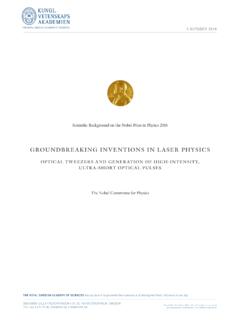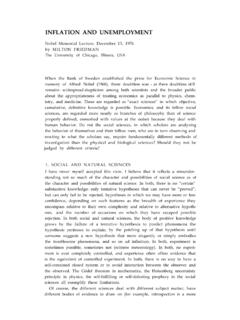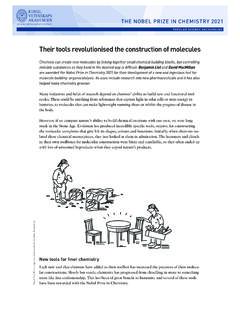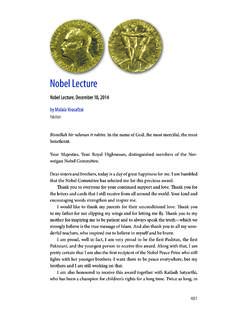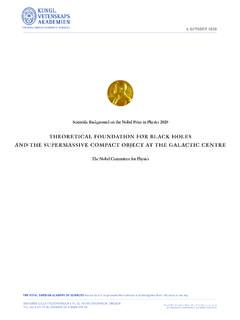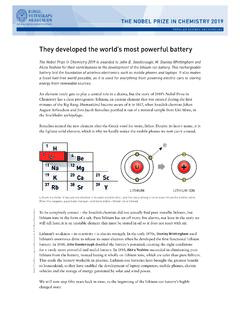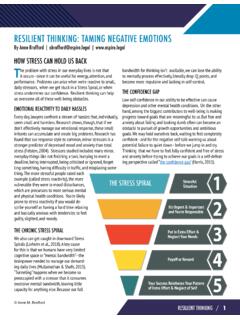Transcription of LITHIUM-ION BATTERIES - Nobel Prize
1 Nobel Prize and the Nobel Prize medal design mark are registrated trademarks of the Nobel Foundation9 OCTOBER 2019 Scientific Background on the Nobel Prize in Chemistry 2019 LITHIUM-ION BATTERIESTHE ROYAL SWEDISH ACADEMY OF SCIENCES has as its aim to promote the sciences and strengthen their influence in 50005 (LILLA FRESCATIV GEN 4 A), SE-104 05 STOCKHOLM, SWEDEN TEL +46 8 673 95 00, 1 (13) LITHIUM-ION BATTERIES The Royal Swedish Academy of Sciences has decided to award John B. Goodenough, M. Stanley Whittingham, and Akira Yoshino the Nobel Prize in Chemistry 2019, for the development of LITHIUM-ION BATTERIES . Introduction Electrical energy powers our lives, whenever and wherever we need it, and can now be accessed with evermore ease and efficiency - even in the absence of nearby power outlets.
2 We increasingly move in unbound and wireless ways, and enjoy high mobility in a potentially healthier local environment. This dramatic development has been made possible by efficient energy storage devices, where high-capacity BATTERIES enable, for example, a variety of electrically-driven tools and vehicles. In principle, we all can enjoy the use of mobile phones, cameras, laptops, power tools, etc., relying on efficient BATTERIES to power them. As a consequence of modern battery technology, electric vehicles are also becoming increasingly popular, and we are in the middle of a switch away from vehicles powered by fossil fuels.
3 In addition, efficient energy storage is an important complement to fluctuating energy sources, such as wind and sunlight. With BATTERIES , the supply-demand chain can thus be balanced over time, even in situations when no energy can be produced. To a large extent, these developments have been made possible by the LITHIUM-ION battery. This type of battery has revolutionized the energy storage technology and enabled the mobile revolution. Through its high potential, and high energy density and capacity, this battery type has already contributed to improving our lives, and arguably will continue to do so in the years to come. However, battery development is very daunting and challenging in general, and perhaps particularly so when it comes to lithium-based cells.
4 Ever since Alessandro Volta presented his famous pile around 1800,1 tremendous effort has been invested in the development of BATTERIES . Many scientists and engineers, working in academia, industry, and even independently, have contributed to this development, realizing that the identification of solutions for efficient BATTERIES is a highly difficult task. The development has thus been relatively sluggish and only very few efficient battery configurations have been successfully designed over the years. For example, we still rely on the lead acid battery discovered in the mid-19th ,3 Nevertheless, due to several ground-breaking multidisciplinary scientific discoveries, encompassing electrochemistry, organic/inorganic chemistry, materials science, etc.
5 , these challenges could indeed be met, and the LITHIUM-ION battery become a reality that essentially changed our world. 2 (13) Background The working principle of a battery is relatively straightforward in its basic configuration (Figure 1). The cell is composed of two electrodes, each connected to an electric circuit, separated by an electrolyte that can accommodate charged species. Frequently, the electrodes are physically separated by a barrier material that prevents them from coming into physical contact with one another, which would cause the battery to short-circuit. In the discharge mode, when the battery serves to drive the electric current, an oxidation process takes place at the negative electrode (anode), resulting in electrons moving from the electrode through the circuit.
6 A complementary reduction process takes place at the positive electrode (cathode), replenished by electrons from the circuit. The cell voltage largely depends on the potential difference of the electrodes, and the overall process is spontaneous. For rechargeable (secondary) BATTERIES the process can be reversed and external electricity can be used to produce complementary redox reactions at the electrodes. This process is energy-dependent and non-spontaneous. Figure 1. Working principle of basic battery in the discharge mode (Galvanic element). Spontaneous redox processes at the electrodes result in electric current through the circuit. In the charge mode (electrolytic cell), electricity-driven redox processes take place at the electrodes resulting in reversal of the spontaneous process.
7 The voltaic pile was made of alternating discs of two metals, one of which tin or zinc and the other copper or silver, separated by layers of cardboard or leather soaked in an aqueous Each pair of metal discs and an electrolyte layer made up a battery cell, and the pile was composed of about 20 stacked cells. During operation, in the case of the Zn/Cu cell, the zinc metal acted as an anode, releasing electrons to the circuit and producing metal ions (oxidation), whereas the opposite electrode reaction was dependent on the working conditions. In the presence of air, the copper metal became partially oxidized to CuO, and reduction of CuO to Cu took place at the electrode.
8 In the absence of air, the protons in the electrolyte were instead reduced to hydrogen gas at the copper surface. The cell voltage was approximately V, depending on air 3 (13) The voltaic pile was essentially a primary battery and not rechargeable. When connecting the poles of the whole device, Volta could demonstrate how the resulting current could generate a spark. After a demonstration of the discovery to Napoleon Bonaparte, the First Consul of the Cisalpine republic was so impressed that he immediately made Volta a The ubiquitous lead acid battery, still used as a starter battery in cars, was studied by Wilhelm J.
9 Sinsteden as early as 1854 and demonstrated by Gaston Plant in 1859 4,6 The battery has a working principle similar to the voltaic pile exposed to air, but was the first so called secondary battery that could be recharged. The term secondary was derived from early studies by Nicolas Gautherot, who in 1801 observed short secondary currents from disconnected wires used in electrochemical The lead acid battery is based on two lead electrodes, at least one of which partially oxidized to lead oxide (PbO2), separated by a sulfuric acid-containing electrolyte. During discharge, oxidation takes place at the lead electrode (anode), producing electrons, protons, and lead sulfate (PbSO4), whereas the lead oxide is reduced to PbSO4 at the cathode.
10 In this case, the cell potential is about 2 V, and a typical 12-V car battery is composed of six cells connected in series. Another milestone in battery development came in 1899, when Waldemar Jungner described the first nickel-iron (Ni-Fe) and nickel-cadmium (Ni-Cd) ,9 Shortly after, Thomas A. Edison also described such These alkaline BATTERIES became predecessors to the later nickel-metal hydride (Ni-MH) battery, which was commercialized in 1989. Lithium By the mid-2oth century, the limited energy densities and capacities of the developed BATTERIES inspired the search for better configurations, and lithium became a target. This metal, discovered by Johan August Arfwedson and named by him and J ns Jakob Berzelius in 1817,11,12 was considered to have excellent properties to serve as a battery element (Figure 2).
